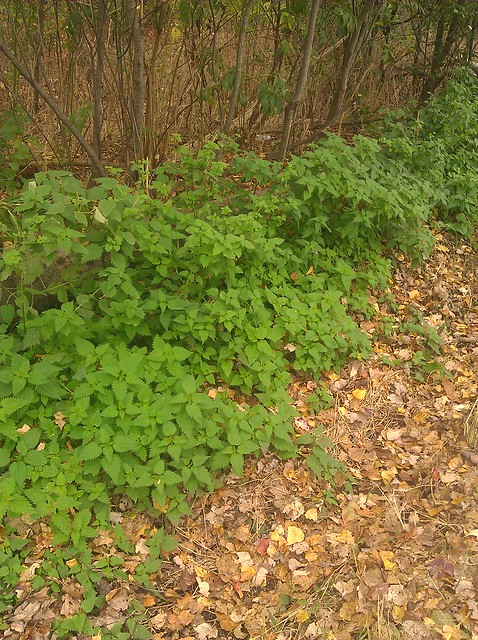Why, I want them for dinner!
Several years ago I swooned over a some nettle soup I was served at a foraging dinner in Boston. First off, the color was lovely; you all know how I feel about green food. The soup happened to be delicious, too -- it tasted slightly of spinach, and with a shaving of nutmeg and Parmesan cheese, the humble soup sent me to Nirvana. I could hardly believe the flavor came from a plant most people consider a nuisance, even though I'm well aware how delicious foraged foods can be.
Stinging nettles are easy to identify. They tend to grow in lush patches and their dark green serrated leaves look distinctive to me, but if you're not sure, give the stem a light pinch and ow! Feel that nasty sting? A sure sign you've got yourself some nettles.
Last week I was biking over to Lexington and I noticed great patches of stinging nettles:

This ground was barren throughout the spring and summer, but now in late fall, it's teeming with nettles. When I got home I did a quick Google search and learned that stinging nettles frequently emerge before winter, and that their tender young growth dies off with the first hard frost.
So yes, later that day I was back over in the patch with my scissors, gloves, and plastic bags. I picked enough nettles to make a huge batch of nettle pesto. Oliver, a picky eater, devoured it when swirled through a plate of pasta. I did not enlighten him that the green stuff did not come from my garden.
Does the pesto sting going down? Good question! Before using nettles in a recipe, you must blanch them in boiling salted water for a couple minutes to remove the stinging hairs/chemicals on the leaves and stems. Two minutes seems to do the trick, then I give them a cold water bath to keep the leaves bright green.
I don't have a formal recipe for my stinging nettle pesto, but here's a general guideline.
Ingredients:
One plastic bag filled with stinging nettles (including stems and leaves)
1/2 cup walnuts (or pine nuts -- I avoid pine nuts since most originate in China and I avoid buying food from China)
2 cloves garlic, minced (more or less to taste)
2 ounces Parmesan cheese, crumbled
Extra virgin olive oil, about 1/2 cup
Salt and pepper to taste
Directions:
1. Bring a large pot of salted water to boil. Wear gloves to place the stinging nettles, stems and all, into the water. Cook for about two minutes, drain, and rinse with cold water. Now you can take your gloves off. Strip the nettle leaves off the stems; toss out stems. Squeeze water out of leaves and place them in a bowl of a food processor.
2. Add the nuts, garlic and cheese to the bowl and process. While the processor is running, slowly pour the olive oil through the feed tube and process until you have a pesto that meets your consistency requirements. (I like mine a little chunky -- you might like yours smooth and silky, which may require lots more oil.) Add salt and pepper to taste. Go forth and serve!

OMG! When I was a kid, I fell off the branch of a tree into a patch of these boogers. It hurt like hell. I remember my Dad putting vinegar on me to stop the sting. (I was covered with stings, like small welts, from my butt down the backs of both legs). I would NEVER think to eat them.
ReplyDeleteI had no idea! We used to live on a rural property that had a huge patch of stinging nettles. I had no idea I could have been harvesting them!
ReplyDelete